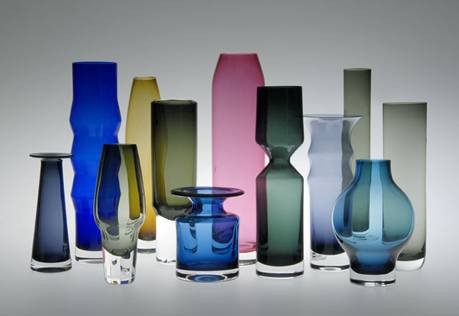Gralglas
dal 29/6/2011 al 17/9/2011
Segnalato da
29/6/2011
Gralglas
Pinakothek der Moderne, Munich
1930-1981. An example of german design. In keeping with the ideals of the Deutscher Werkbund and influenced by the modern style of Northern Europe, Gralglas evolved into a glassworks in its own right during the post-war period, by this time based in Durnau. The high quality, plain objectivity, clear functionality and affordability of its glass products were a symbol of Gute Form (good design) - and were soon to be found in representative official residences of the still young Federal Republic of Germany.

Blazing light, mystical spirituality, magical allure, life-giving chalice – the ‘Grail’ is the stuff of many legends. And a Swabian family company claimed the German word ‘Gral’ for itself and used it as an expression of its fascination with the material glass. For more than half a century, the Gral glassworks was one of the leading German glass manufacturers of the 20th century.
With the support of one of the major Modernist glass artists – Wilhelm von Eiff, professor at the Kunstgewerbeschule in Stuttgart – the Gral glass workshops in Göppingen developed into one of the most advanced finishing plants for cutting and engraving until WWII.
In keeping with the ideals of the Deutscher Werkbund and influenced by the modern style of Northern Europe, Gralglas evolved into a glassworks in its own right during the post-war period, by this time based in Dürnau. The high quality, plain objectivity, clear functionality and affordability of its glass products were a symbol of Gute Form (good design) – and were soon to be found in representative official residences of the still young Federal Republic of Germany. The standard and status of the Gral glassworks was roughly comparable internationally with the Daum glass company in France, Iittala in Finland, Orrefors in Sweden, Leerdam in the Netherlands, Riedel in Austria, Rosenthal in Germany and Venini in Italy, with which Gralglas was linked through the ‘Group 21’. External industrial designers, artists and international glass specialists, including Hans Theo Baumann and Hartmut Esslinger, as well as Murano glass artists such as Livio Seguso, became responsible for Gral’s new style. Apart from mass-produced everyday glassware, individual artistic pieces manufactured in in-house workshops from the end of the 1960s onwards testify to the high-quality design, the skill of the craftsmen and the delight in technical experimentation that strove to entice an ever greater power of expression from the material glass.
Complemented by design drawings that widen our picture of the design process, selected pieces reflect the Gral glassworks’ multifacetted richness in this first comprehensive retrospective: wafer-thin chalices and footed beakers, strict stereometry and unconstrained forms, lucid transparency and saturated coloured landscapes.
An exhibition catalogue edited by Helmut Ricke and Wilfried van Loyen, with contributions by Xenia Riemann, Die Neue Sammlung – The International Design Museum Munich, accompanies the exhibition.
An exhibition of Die Neue Sammlung – The International Design Museum Munich. In cooperation with the Glasmuseum Hentrich in the Museum Kunstpalast Düsseldorf and The Finnish Glass Museum, Riihimäki.
Image: Hans Theo Baumann, Glass vases, 1960s, Gral-Glashütte, Dürnau
Photo: Die Neue Sammlung – The International Design Museum Munich (A. Laurenzo)
Further information and pictorial material:
Dr. Corinna Rösner
Die Neue Sammlung – The International Design Museum Munich
T +49 (0)89 272725-0
e-mail: presse@die-neue-sammlung.de
Press conference: THU, 30.06.2011, 11.00
Opening: THU, 30.06.2011, 19.00
Pinakothek der Moderne
Die Neue Sammlung, Barerstrasse 40 München



